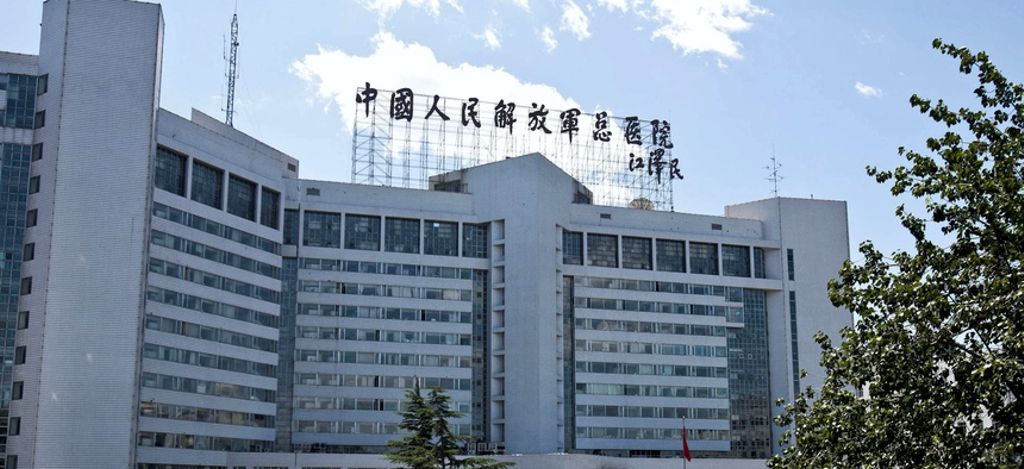
We may be on the verge of a brave new world indeed. Today’s advances in biotechnology and genetic engineering have exciting applications in medicine — yet also alarming implications, including for military affairs. China’s national strategy of military-civil fusion (军民融合) has highlighted biology as a priority, and the People’s Liberation Army could be at the forefront of expanding and exploiting this knowledge.
The PLA’s keen interest is reflected in strategic writings and research that argue that advances in biology are contributing to changing the form or character (形态) of conflict. For example:
- In 2010’s War for Biological Dominance (制生权战争), Guo Jiwei (郭继卫), a professor with the Third Military Medical University, emphasizes the impact of biology on future warfare.
- In 2015, then-president of the Academy of Military Medical Sciences He Fuchu (贺福初) argued that biotechnology will become the new “strategic commanding heights” of national defense, from biomaterials to “brain control” weapons. Maj. Gen. He has since become the vice president of the Academy of Military Sciences, which leads China’s military science enterprise.
- Biology is among seven “new domains of warfare” discussed in a 2017 book by Zhang Shibo (张仕波), a retired general and former president of the National Defense University, who concludes: “Modern biotechnology development is gradually showing strong signs characteristic of an offensive capability,” including the possibility that “specific ethnic genetic attacks” (特定种族基因攻击) could be employed.
- The 2017 edition of Science of Military Strategy (战略学), a textbook published by the PLA’s National Defense University that is considered to be relatively authoritative, debuted a section about biology as a domain of military struggle, similarly mentioning the potential for new kinds of biological warfare to include “specific ethnic genetic attacks.”
These are just a few examples of an extensive and evolving literature by Chinese military scholars and scientists who are exploring new directions in military innovation.
Following these lines of thinking, the PLA is pursuing military applications for biology and looking into promising intersections with other disciplines, including brain science, supercomputing, and artificial intelligence. Since 2016, the Central Military Commission has funded projects on military brain science, advanced biomimetic systems, biological and biomimetic materials, human performance enhancement, and “new concept” biotechnology.
Gene Editing
Meanwhile, China has been leading the world in the number of trials of the CRISPR gene-editing technology in humans. Over a dozen clinical trials are known to have been undertaken, and some of these activities have provoked global controversy. It’s not clear whether Chinese scientist He Jiankui, may have received approval or even funding from the government for editing embryos that became the world’s first genetically modified humans. The news provoked serious concerns and backlash around the world and in China, where new legislation has been introduced to increase oversight over such research. However, there are reasons to be skeptical that China will overcome its history and track record of activities that are at best ethically questionable, or at worst cruel and unusual, in healthcare and medical sciences.
But it is striking how many of China’s CRISPR trials are taking place at the PLA General Hospital, including to fight cancer. Indeed, the PLA’s medical institutions have emerged as major centers for research in gene editing and other new frontiers of military medicine and biotechnology. The PLA’s Academy of Military Medical Sciences, or AMMS, which China touts as its “cradle of training for military medical talent,” was recently placed directly under the purview of the Academy of Military Science, which itself has been transformed to concentrate on scientific and technological innovation. This change could indicate a closer integration of medical science with military research.
In 2016, an AMMS doctoral researcher published a dissertation, “Research on the Evaluation of Human Performance Enhancement Technology,” which characterized CRISPR-Cas as one of three primary technologies that might boost troops’ combat effectiveness. The supporting research looked at the effectiveness of the drug Modafinil, which has applications in cognitive enhancement; and at transcranial magnetic stimulation, a type of brain stimulation, while also contending that the “great potential” of CRISPR-Cas as a “military deterrence technology in which China should “grasp the initiative” in development.
AI + Biotech
The intersection of biotechnology and artificial intelligence promises unique synergies. The vastness of the human genome — among the biggest of big data — all but requires AI and machine learning to point the way for CRISPR-related advances in therapeutics or enhancement.
In 2016, the potential strategic value of genetic information led the Chinese government to launch the National Genebank (国家基因库), which intends to become the world’s largest repository of such data. It aims to “develop and utilize China’s valuable genetic resources, safeguard national security in bioinformatics (生物信息学), and enhance China’s capability to seize the strategic commanding heights” in the domain of biotechnology.
The effort is administered by BGI, formerly known as Beijing Genomics Inc., which is Beijing’s de facto national champion in the field. BGI has established an edge in cheap gene sequencing, concentrating on amassing massive amounts of data from a diverse array of sources. The company has a global presence, including laboratories in California and Australia.
U.S. policymakers have been concerned, if not troubled, by the company’s access to the genetic information of Americans. BGI has been pursuing a range of partnerships, including with the University of California and with the Children’s Hospital of Philadelphia on human genome sequencing. BGI’s research and partnerships in Xinjiang also raise questions about its linkage to human rights abuses, including the forced collection of genetic information from Uighurs in Xinjiang.
There also appear to be links between BGI’s research and military research activities, particularly with the PLA’s National University of Defense Technology. BGI’s bioinformatics research has used Tianhe supercomputers to process genetic information for biomedical applications, while BGI and NUDT researchers have collaborated on several publications, including the design of tools for the use of CRISPR.
Biotech’s Expansive Frontier
It will be increasingly important to keep tabs on the Chinese military’s interest in biology as an emerging domain of warfare, guided by strategists who talk about potential “genetic weapons” and the possibility of a “bloodless victory.” Although the use of CRISPR to edit genes remains novel and nascent, these tools and techniques are rapidly advancing, and what is within the realm of the possible for military applications may continue to shift as well. In the process, the lack of transparency and uncertainty of ethical considerations in China’s research initiatives raise the risks of technological surprise.
By ELSA B. KANIA and WILSON VORNDICK
Read Original Article on DefenseOne.com
About Defense One
Defense One delivers news, breaking analysis, and ideas on the topics and trends that are defining the future of U.S. defense and national security. We give national security professionals, stakeholders and citizens what they need to know, from senior leaders in Washington to commanders abroad and next-generation thinkers far from the political scrum.
Founded in 2013, Defense One is a high-level, highly visible conversation destination. Our staff provide analysis of the hottest news events of the day and in-depth stories shining a critical light on the national security landscape. We publish innovative, fearless commentary from old hands and new voices in the national-security community.






